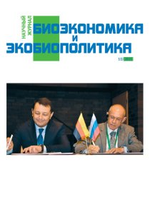Monoclonal Antibodies against Staphylococcus Enterotoxin A. Production, Characterization, Toxin Neutralization Capability
Авторы: Лоскутова И. В., Щанникова М. П., Шепеляковская А. О., Фурсова К. К., Артыков А. А., Семушина С. Г., Бровко Ф. А.
Рубрика: Тезисы
Опубликовано в Биоэкономика и экобиополитика №1 (1) декабрь 2015 г.
Дата публикации: 30.01.2016
Статья просмотрена: 12 раз
Библиографическое описание:
Monoclonal Antibodies against Staphylococcus Enterotoxin A. Production, Characterization, Toxin Neutralization Capability / И. В. Лоскутова, М. П. Щанникова, А. О. Шепеляковская [и др.]. — Текст : непосредственный // Биоэкономика и экобиополитика. — 2015. — № 1 (1). — URL: https://moluch.ru/th/7/archive/20/692/ (дата обращения: 26.04.2025).
Staphylococcus producevarious virulence factors,which are the causes of their pathogenicity. Among such factors special place belongs to enterotoxins - superantigens. Staphylococcal enterotoxin A (SEA) is the most widespread of them. It xcan led to imbalance of the immune system. Therefore, the development of methods of SEA neutralization and the search of functionally important regions of SEA molecule is an actual problem.
The aim of this research is to study the topography of SEA molecule surface using antibodies. The main idea of our research - is identification of SEA molecule regions whish are significant for SEA functioning. Murine monoclonal antibodies are chosen as a research tool.
We generated 20 murine monoclonal antibodies (mAbs) to SEA in BALB/C mice. We evaluated affinity constants for these antibodies and determined H-chain and L-chain types. Cross reactivity with other enterotoxins was investigate.
We determined the conditions for SEA toxicity estimates by animal model. The optimal level of toxicity was observed in C57BL / 6 mice, with administration of lipopolysaccharide (LPS) of E.coli at a dose 150 micrograms per animal 3 hours after injection of SEA. It was determined, thatLD50 of SEA is 0.5 micrograms per animal and LD100 is 1,5 micrograms per animal. We used this mice model in further search of toxin-neutralizing mAbs.
Animals were injected with SEA and LPS. To test the protective efficacy, mice were injected with one of the mAb in the five-fold molar excess 10 min prior to administration of SEA. Control mice were treated with LPS and PBS. Mortality of animals were recorded within three days. We tested 20 mAbs. It was established that the antibodies tested differ in their toxin neutralizing activity. Several antibodies did not affect SEA toxicity. Some antibodies had high toxin-neutralizing activity and decreased lethality by 83%, while two antibodies were very effective in lethality reducing test neutralizing SEA toxicity up to 100%.







